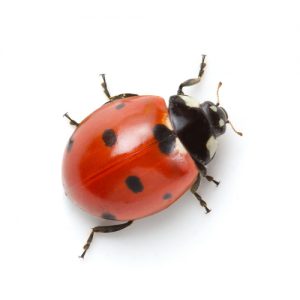Lady Beetles Will Soon Move Into Homes
By Chris Williams on August 23, 2012.
Q. I know there are several insects that can move into homes in the fall. We don’t have any problem with the stink bugs but we do have a problem with lady beetles getting inside. How do we know if the ones we have are the Asian lady beetles or the regular lady beetles that are good guys? I might treat them differently if I knew.
A. Actually even the multicolored Asian lady beetles (ALBs) are basically good guys—that sometimes break bad. All lady beetle adults and larvae are predators on other insects and mites. They feed primarily on plant pests like aphids and so have always been friends of gardeners and farmers. In fact, we probably created our own problem with the ALB. It was introduced into the U.S. to control agricultural pests. Experts didn’t expect populations to explode with few natural enemies to provide control. Since the first field populations were found in Louisiana in 1988, the Asian lady beetle has expanded into most of the U.S. and Canada. 
It can be difficult to tell the multicolored Asian lady beetle (Harmonia axyridis) from other lady beetles because it comes in so many different color combinations, varying from mustard yellow to tan to orange to red to black. You can’t reliably count the number of spots on their backs either since the black or red spots vary from none to two to 16 or more. The most common U.S. form is pumpkin orange with 16 black spots. One way that you might be able to identify your beetles as ALBs is that most of them (but not all) have a small dark, W-shaped marking on a white background just behind the head.
Simply the fact that the beetles are entering your home in large numbers means that they are probably multicolored Asian lady beetles. Our native lady beetles don’t usually occur in such large numbers and aren’t as likely as the ALBs to migrate in large numbers. And once the beetles are in your home, it really doesn’t matter what type of lady beetle you have, the annoyance level is the same and varies depending on the number of beetles and your tolerance for them.
Lady beetles don’t actively look for houses. As the weather cools in the fall and their insect food supply dwindles, they look for protected places in which to spend the winter. Usually this is under bark, logs, in rock crevices, or other hidden places. But homes and other buildings work just as well. Beetles leave fields and fly to buildings usually in September or October and usually on sunny afternoons. Homes near fields or woods are most likely to have lady beetle visitors in the fall.
Many beetles will overwinter outside around your home, under siding and in other places, but if the beetles can find a way into your home, they will make themselves welcome. They enter homes through gaps around doors or windows, or cracks or crevices around the roof line, around utility lines, and through any other opening. They congregate in attics, wall voids or ceiling voids, or simply behind baseboards or door frames. On warm winter days, or in early spring, the beetles become active again and will move about, looking for a way out of the house. They’re attracted to light and are often found around windows or lights. You can help them back outside or can remove them with a vacuum cleaner. Be careful when vacuuming them up, since they can release a smelly, yellow defensive fluid which can stain fabrics.
The best way to prevent winter insect visitors is to pest-proof your home. Give Colonial a call. Our technicians can locate and seal all of those little openings around your house that let pests inside. We can install door sweeps and thresholds, and caulk around windows. We can also treat around the outside perimeter of your home to intercept Asian lady beetles and other fall invaders before they can get inside. Call Colonial today to set up a pest management program before the summer ends.